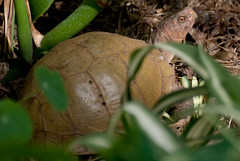Every year a small flock of Hooded Orioles arrive in the spring and stay for the summer before heading back south for the winter. The first birds to arrive in the spring are the breeding males who start arriving sometime between early March and mid-May. The females and juveniles arrive a few weeks later.

Hooded Oriole, Adult Male
After spending the summer jockeying for position at the oriole feeder and sucking down nectar the males start leaving, usually starting between mid-September and early October, with all birds gone by late October.

Hooded Oriole, Adult Female
Well, this year they split early. I haven't seen a breeding male in almost a week, since 13 August. And the female population also seems to be getting pretty thin. As of the middle of last week I was still seeing up to two adult males at a time in the yard and up to four adult females at a time. As of yesterday, no males and only one female at a time.
Granted, it sure feels like fall. Of course, it's felt like fall most of the summer. My garden is located in San Jose, CA. It's August. We're supposed to have most days in the 80s and many days in the 90s, sometimes climbing into the 100s. We haven't seen a day over 80 since mid-July. More and more mornings the cloud cover doesn't burn off till after 10 AM. Usually it's gone by 9.
So, the orioles have declared it to be the end of summer.












My winter bulbs are starting to come up, too. I'm pretty sure this is much earlier than usual.
ReplyDeleteFunny about bird colors; I can really see the yellow in the female in your beautiful photos. Sitting in the yard in the shade with the full sun on the feeder at your party, I thought she was a gray bird and I was surprised when someone else said she was yellow. When she came back, I detected a very slight yellowish tinge but she still looked mostly gray to me.
I like the little bee hovering under the feeder, too.
I think the shorter days have combined with the coolness of the lack-of-summer days to make everything think it really is already fall.
ReplyDeleteThanks for the photo complements, but they're not mine. Merely for illustration. As you noted, the light angles available in my yard don't make for decent color capture. Also, some of the females are a lot more yellow than others, some more olive-drab. the males, tho, are quite striking. All of them!